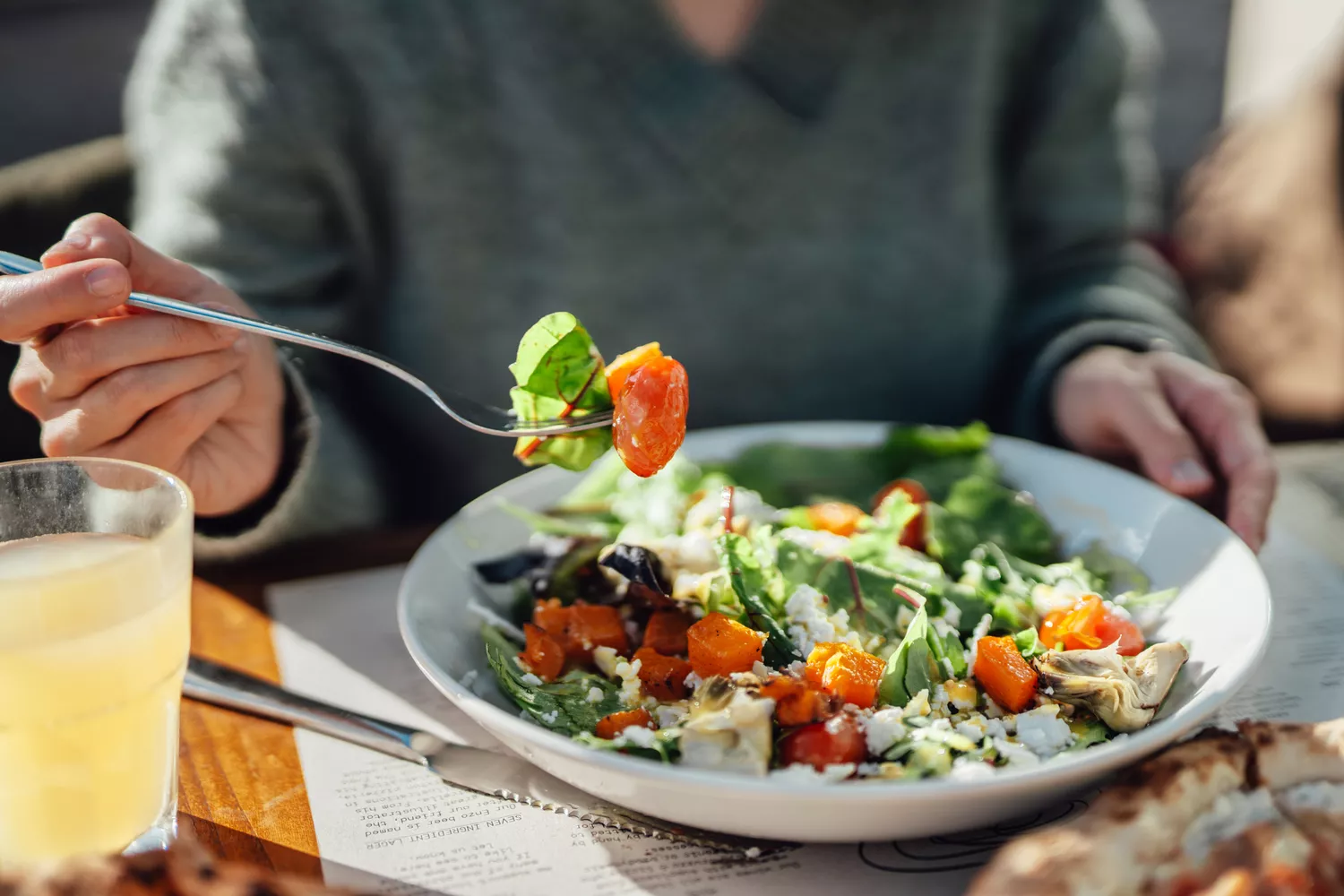The Paleo diet is a modern-day take on the dietary pattern of humans living throughout the Paleolithic or “Old Stone Age” period, which was about 2.5 million years back. During the Paleolithic period, human beings followed a diet plan that was composed of plants like root veggies, seeds, nuts, and protein sources such as wild game, seafood, and pests.1.
The modern-day Paleo diet plan was popularized by researcher Loren Cordain, who composed the 2002 book “The Paleo Diet: Lose Weight and Get Healthy by Eating the Foods You Were Designed to Eat,” which described Cordain’s take on the Paleo diet plan and how it can be used to improve overall health.
Since the Paleo diet plan is based upon the diet plan of individuals living millions of years back, it restricts numerous foods that prevail in modern diet plans, such as grains, vegetables, dairy, and sugarcoated. While the Paleo diet has actually been linked to a couple of health advantages– including lowering blood glucose and blood lipid levels– some professionals alert that this diet is unnecessarily restrictive.
When following a Paleo diet, your diet will primarily include fruits, vegetables, nuts, seeds, and protein sources. Clearly, people living during the Paleolithic age had more limited food options than we do now, so the Paleo diet plan isn’t a precise representation of ancient diets. The Paleo diet is rather utilized as a method to focus on nutrient-dense, whole foods while decreasing usage of ultra-processed foods that are so typical in many people’s diet plans.
Keep reading to find out more about the Paleo diet plan, including foods to eat and avoid, and how this eating pattern might affect your health.
What You Can Eat.
When following a Paleo diet plan, you’ll prioritize entire, nutrient-dense foods.
According to some research, a Paleo diet plan supplies around 35{3ce0ad748aa90072994365178fd728c9d7c9d879343909fd1337f07a6240cc7d} of calories from carbohydrates, 35{3ce0ad748aa90072994365178fd728c9d7c9d879343909fd1337f07a6240cc7d} from fats, and 30{3ce0ad748aa90072994365178fd728c9d7c9d879343909fd1337f07a6240cc7d} from proteins, which is considered a low-carb method of eating.2.
The following foods are permitted on the Paleo diet:.
Meat and poultry: Beef, lamb, pork, chicken, duck, and turkey.
Eggs: Whole eggs and egg whites.
Seafood: Salmon, cod, trout, sardines, clams, mussels, and shrimp.
Veggies: Greens, artichokes, zucchini, asparagus, butternut squash, carrots, sweet potatoes, and broccoli.
Fruits: Berries, cherries apples, peaches, pears, and avocados.
Nuts and seeds: Pecans, Brazil nuts, macadamia nuts, no-sugar-added peanut butter, pumpkin seeds, hazelnuts, and walnuts.
Specific fats: Olive oil, ghee, avocado oil, and coconut yogurt.
Herbs and spices: Turmeric, rosemary, black pepper, and mint.
In addition to the foods noted above, there are lots of Paleo-friendly products, such as baking blends, crackers, breads, and even treats like muffins and cookies that can fit into a paleo diet plan.
Paleo-approved items are made with Paleo-friendly active ingredients, such as coconut and almond flour as well as natural sweeteners like dates and monk fruit.
What You Should Avoid Eating.
When following the Paleo diet plan, you’ll require to cut out many commonly consumed foods and ingredients. The Paleo diet leaves out some nutritious foods such as grains, vegetables, and dairy items. It likewise limits refined sugars, ultra-processed foods, and some oils.2.
Here’s a list of foods you’ll need to prevent when on the Paleo diet:.
Grains: Wheat, barley, farro, rice, corn, oats, and rice.
Legumes: Lentils, black beans, chickpeas, and kidney beans.
Dairy items: Milk, yogurt, butter, cottage cheese, and sour cream.
Improved sugar: White sugar, agave, brown sugar, and corn syrup.
Ultra-processed foods: Potato chips, cereal bars, candy, and other snack foods.
Some oils: Canola oil, corn oil, soybean oil, and safflower oil.
Artificial sweeteners: Sucralose, aspartame, and saccharin.
Remember that there’s no rigorous set rules laying out every food and beverage that need to be prevented when following a Paleo diet plan.
This suggests that some people are more restrictive than others when it comes to their food options. While some people following a Paleo diet plan will eat snack foods like crackers and cookies made with Paleo ingredients, others may choose to avoid those foods and stay with a more traditional Paleo consuming pattern.
In basic, you’ll wish to keep your usage of processed foods, such as junk food like chips and sugary foods, to a minimum when following a Paleo diet plan.

Benefits of the Paleo Diet.
The Paleo diet plan concentrates on restricting ultra-processed foods and sugarcoated while prioritizing whole, nutrient-dense foods known to support health, like vegetables and nuts.
Some research findings suggest that the Paleo diet might offer a few health benefits, consisting of reducing blood glucose levels and encouraging weight-loss.
Here are some of the methods which following a Paleo diet may benefit health.
It May Support Healthy Blood Sugar Levels.
The Paleo diet restricts foods that may adversely affect blood sugar, such as ultra-processed snack foods and sugary beverages. People with high blood sugar level levels who transition to a Paleo diet plan may experience reductions in their blood sugar levels.
A 2017 research study that consisted of 32 people with type 2 diabetes found that 12 weeks of following a Paleo diet led to decreases in both short and long-lasting markers of blood sugar control, which were more considerable when the Paleo diet plan was combined with one-hour supervised exercise sessions 3 times per week. The exercise group experienced a 1.1{3ce0ad748aa90072994365178fd728c9d7c9d879343909fd1337f07a6240cc7d} reduction in the long-term marker of blood glucose control hemoglobin A1c, while the diet-only group experienced a. 9{3ce0ad748aa90072994365178fd728c9d7c9d879343909fd1337f07a6240cc7d} decrease.3.
The participants also experienced enhancements in their sensitivity to insulin, a hormone that shuttles blood sugar level into cells where it can be used for energy.
A 2017 review of 4 studies found that Paleo diet plan interventions were more efficient for lowering fasting blood glucose levels in individuals with one or more of the 5 components of metabolic syndrome, a cluster of symptoms including high blood sugar levels that increases an individual’s risk for establishing type 2 diabetes and cardiovascular disease.
It May Encourage Weight Loss.
People frequently attempt out the Paleo diet as a way to promote fat loss. Individuals following the Paleo diet might feel more satisfied after meals, which could help overeating and encourage weight loss.
A 2019 evaluation of 11 studies with intervention durations varying from 2 weeks to two years discovered that, typically, people who followed a Paleo diet plan lost about 8 pounds more than those following other consuming patterns.5.
In addition, a 2021 study that included 32 people with type 2 diabetes found that after following the Paleo diet plan for 12 weeks, the participants lost approximately 15.6 pounds.
Might Reduce Heart Disease Risk Factors.
Having elevated blood pressure and blood lipid levels like LDL cholesterol and triglycerides increases your threat of developing heart problem. Some research studies have discovered that individuals who follow the Paleo diet experience decreases in heart problem danger factors such as triglyceride and blood pressure levels.
In the 2021 study pointed out above, the 12-week Paleo diet plan intervention was related to lower systolic blood pressure and triglycerides. Remarkably, the reduction in triglyceride levels was independent of weight loss, indicating that the composition of the diet plan was effective for enhancing blood lipid levels.6.
This might be due to the fact that the individuals decreased their consumption of saturated fatty acids while increasing their consumption of monounsaturated fats and polyunsaturated fats, both of which have helpful impacts on blood lipid levels.
A 2022 mate research study that consisted of info on 18,210 Spanish adults found that, throughout a 12-year time period, those who followed a Paleo dietary pattern were considerably less likely to develop heart disease. The scientists kept in mind that this association was likely due to the low usage of ultra-processed foods in Paleo dietary patterns.7.
Disadvantages of the Paleo Diet.
Even though the Paleo diet plan encourages the intake of healthy foods like veggies and fruits and has actually been linked with some health benefits, there are some drawbacks to think about.
It eliminates some healthy foods: Nutritious foods such as legumes, dairy products, and whole grains are limited on the Paleo diet plan. These foods are high in essential nutrients such as fiber, calcium, and magnesium, which is why some professionals argue that the Paleo diet plan is unnecessarily limiting. 8.
It might adversely affect gut health: A small 2020 study discovered that individuals following a stringent or modified Paleo diet for at least a year had lower levels of particular advantageous germs and greater amounts of trimethylamine (TMA)- producing Hungatella germs compared to those following regular diet plans. TMA is produced by some gut germs after breaking down substances discovered in eggs, red meat, and dairy. TMA is turned into a compound called trimethylamine N-oxide (TMAO). Research studies reveal that having higher levels of TMAO may increase the threat of certain illness, like heart problem. 8.
It could trigger modified defecation: A 2016 research study that randomized 39 healthy women to either a Paleo diet or a normally healthy diet plan that consisted of grains and dairy for 4 weeks found that ladies following the Paleo diet were more likely to experience irregularity and irregular defecation compared to the unrestricted diet plan group.9.
Although a well-planned Paleo diet plan that consists of a lot of plant foods like vegetables and fruits can be a healthful choice, it does restrict some healthy foods, which might not be necessary for many people.
Paleo Diet vs Keto Diet.
The keto diet plan is an extremely low-carb, high fat way of consuming. It’s far more restrictive than a Paleo diet and involves considerably restricting your carbohydrate intake to less than 50 grams per day. The point of the keto diet plan is to reach and keep ketosis, a metabolic state in which the body burns fat for fuel rather of sugar.10.
In order to reach and maintain ketosis, individuals following the keto diet should avoid most high-carb foods, consisting of starchy veggies and fruits.
The Paleo diet plan is various from the keto diet in numerous methods. Although it can be considered a lower-carb diet plan, it doesn’t restrict all high-carb foods. It consists of a variety of starchy vegetables and fruits, which are restricted on the keto diet.2.
The Paleo diet plan can be adapted to match a range of nutrition needs and some people following the Paleo diet plan might include more high-carb foods than others. On the other hand, the keto diet plan isn’t a flexible diet plan, as the function of the diet is to reach and preserve ketosis.



